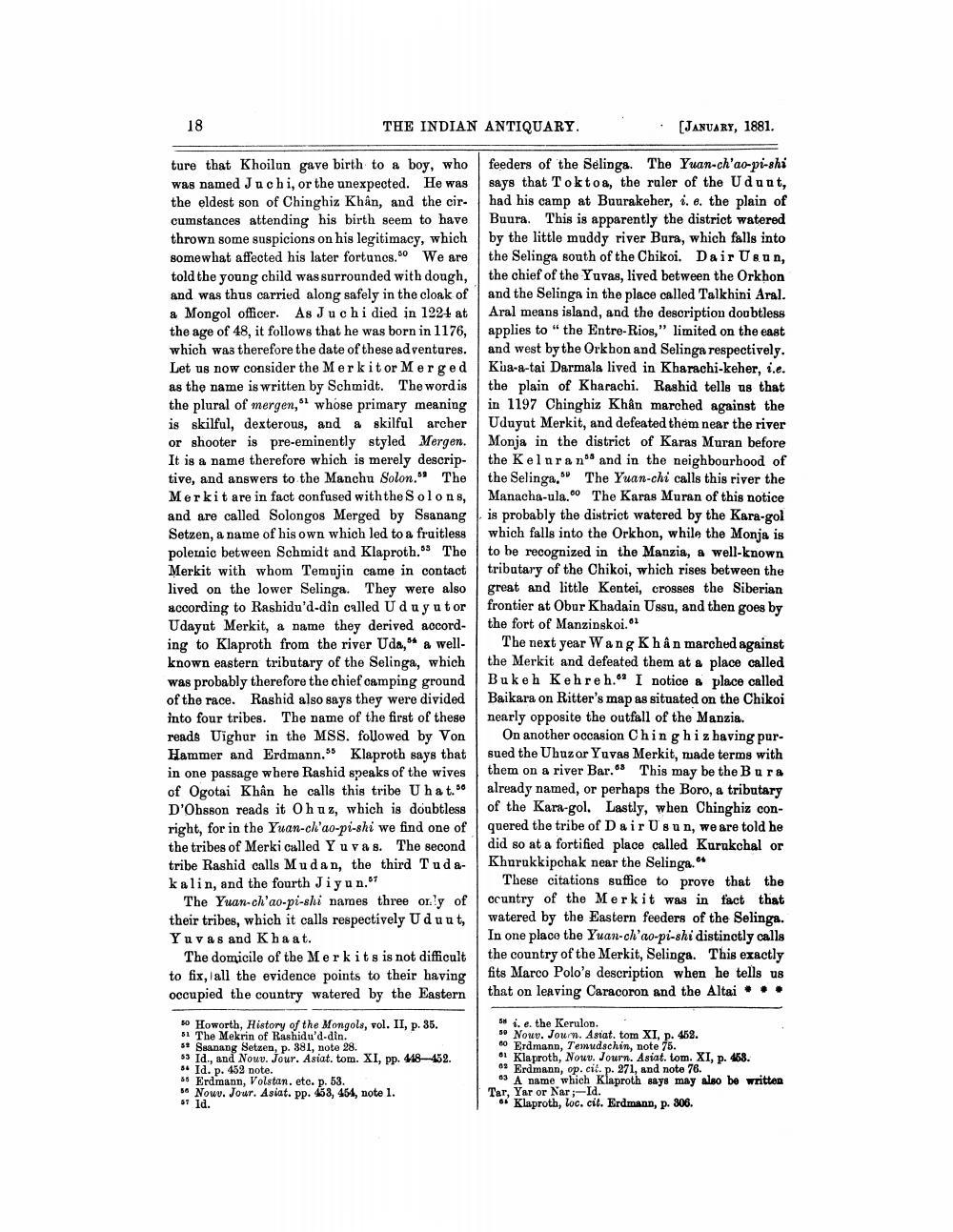________________
18
THE INDIAN ANTIQUARY.
JANUARY, 1881.
ture that Khoilun gave birth to a boy, who feeders of the Selings. The Yuan-ch'ao-pi-shi was named Juchi, or the unexpected. He was says that Toktoa, the ruler of the Udunt, the eldest son of Chinghiz Khân, and the cir. had his camp at Buurakeher, i.e. the plain of cumstances attending his birth seem to have Buura. This is apparently the district watered thrown some suspicions on his legitimacy, which by the little muddy river Bura, which falls into somewhat affected his later fortunos. We are the Selinga south of the Chikoi. Dair Usun, told the young child was surrounded with dough, the chief of the Yuvas, lived between the Orkhon and was thus carried along safely in the cloak of and the Selinga in the place called Talkhini Aral. a Mongol officer. As Juchi died in 1224 at Aral means island, and the description doubtless the age of 48, it follows that he was born in 1176, applies to "the Entre Rios," limited on the east which was therefore the date of these adventures. and west by the Orkhon and Selinga respectively. Let us now consider the Merkit or Merged Kia-a-tai Darmala lived in Kharachi-keher, i.e. as the name is written by Schmidt. The word is the plain of Kharachi. Rashid tells us that the plural of mergen," whose primary meaning in 1197 Chinghiz Khân marched against the is skilful, dexterous, and a skilful archer Uduyut Merkit, and defeated them near the river or shooter is pre-eminently styled Mergen. Monja in the district of Karas Muran before It is a name therefore which is merely descrip- the Keluran and in the neighbourhood of tive, and answers to the Manchu Solon." The the Selinga." The Yuan-chi calls this river the Merkit are in fact confused with the Solons, Manacha-ula. The Karas Muran of this notice and are called Solongos Merged by Ssanang is probably the district watered by the Kara-gol Setzen, a name of his own which led to a fruitless which falls into the Orkhon, while the Monja is poleroic between Schmidt and Klaproth." The to be recognized in the Manzia, a well-known Merkit with whom Temajin came in contact tributary of the Chikoi, which rises between the lived on the lower Selinga. They were also great and little Kentei, crosses the Siberian according to Rashidu'd-din called U duyutor frontier at Obur Khadain Ussu, and then goes by Udayat Merkit, a name they derived accord- the fort of Manzinskoi. ing to Klaproth from the river Uda," a well- | The next year Wang Khân marched against known eastern tributary of the Selinga, which the Merkit and defeated them at a place called was probably therefore the chief camping ground Bukeh Kehreh." I notice a place called of the race. Rashid also says they were divided Baikara on Ritter's map as situated on the Chikoi into four tribes. The name of the first of these nearly opposite the outfall of the Manzia. reads Uighur in the MSS. followed by Von On another occasion Chin ghiz having purHammer and Erdmann. Klaproth says that sued the Uhuzar Yuvas Merkit, made terms with in one passage where Rashid speaks of the wives them on a river Bar. This may be the Bura of Ogotai Khân he calls this tribe U hat." already named, or perhaps the Boro, a tributary D'Obsson reads it Ohuz, which is doubtless of the Kara-gol. Lastly, when Chinghiz conright, for in the Yuan-ch'ao-pi-shi we find one of quered the tribe of Dair Usun, we are told he the tribes of Merki called Yuvas. The second did so at a fortified place called Kurukohal or tribe Rashid calls Mudan, the third Tuda- Khurukkipchak near the Selinga." kalin, and the fourth Jiyu n."
These citations suffice to prove that the The Yuan-ch'ao-pi-shi names three only of country of the Merkit was in fact that their tribes, which it calls respectively U du ut, watered by the Eastern feeders of the Selinga. Yuvas and Khaat.
In one place the Yuan-ch'ao-pi-shi distinctly calls The domicile of the Merkits is not difficult the country of the Merkit, Selinga. This exactly to fix, all the evidence points to their having fits Marco Polo's description when he tells us occupied the country watered by the Eastern
that on leaving Caracoron and the Altai...
e. the Kerulon.
50 Howorth, History of the Mongols, vol. II, p. 35. 51 The Mekrin of Rashidu'd-din. 5Ssanang Setzen, p. 381, note 28. * Id., and Nouv. Jour. Asiat. tom. XI, pp. 448-452. 5* Id. p. 452 note. 36 Erdmann, Volstan. etc. p. 53. 56 Now. Jour. Asiat. pp. 553, 454, note 1.
50 Nouv. Joum. Asiat. tom XI, p. 452. 60 Erdmann, Temudschin, note 75.
1 Klaproth, Nouv. Journ. Asiat. tom. XI, p. 458. 62 Erdmann, op. cit. p. 271, and note 76.
05 A name which Klaproth says may also be written Tar, Yar or Nar;-Id.
61 Klaproth, loc. cit. Erdmann, p. 306.
$1 id.




